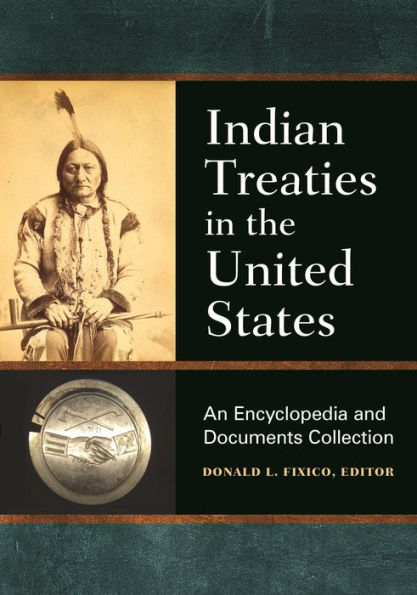This book examines the treaties that promised self-government, financial assistance, cultural protections, and land to the more than 565 tribes of North America (including Alaska, Hawaii, and Canada).
Prior to contact with Europeans and, later, Americans, American Indian treaties assumed unique dimensions, often involving lengthy ceremonial meetings during which gifts were exchanged. Europeans and Americans would irrevocably alter the ways in which treaties were negotiated: for example, treaties no longer constituted oral agreements but rather written documents, though both parties generally lacked understanding of the other's culture.
The political consequences of treaty negotiations continue to define the legal status of the more than 565 federally recognized tribes today. These and other aspects of treaty-making will be explored in this single-volume work, which serves to fill a gap in the study of both American history and Native American history. The history of treaty making covers a wide historical swath dating from the earliest treaty in 1788 to latest one negotiated in 1917. Despite the end of formal treaties largely by the end of the 19th century, Native relations with the federal government continued on with the move to reservations and later formal land allotment under the Dawes Act of 1887.
"1128476412"
Prior to contact with Europeans and, later, Americans, American Indian treaties assumed unique dimensions, often involving lengthy ceremonial meetings during which gifts were exchanged. Europeans and Americans would irrevocably alter the ways in which treaties were negotiated: for example, treaties no longer constituted oral agreements but rather written documents, though both parties generally lacked understanding of the other's culture.
The political consequences of treaty negotiations continue to define the legal status of the more than 565 federally recognized tribes today. These and other aspects of treaty-making will be explored in this single-volume work, which serves to fill a gap in the study of both American history and Native American history. The history of treaty making covers a wide historical swath dating from the earliest treaty in 1788 to latest one negotiated in 1917. Despite the end of formal treaties largely by the end of the 19th century, Native relations with the federal government continued on with the move to reservations and later formal land allotment under the Dawes Act of 1887.
Indian Treaties in the United States: An Encyclopedia and Documents Collection
This book examines the treaties that promised self-government, financial assistance, cultural protections, and land to the more than 565 tribes of North America (including Alaska, Hawaii, and Canada).
Prior to contact with Europeans and, later, Americans, American Indian treaties assumed unique dimensions, often involving lengthy ceremonial meetings during which gifts were exchanged. Europeans and Americans would irrevocably alter the ways in which treaties were negotiated: for example, treaties no longer constituted oral agreements but rather written documents, though both parties generally lacked understanding of the other's culture.
The political consequences of treaty negotiations continue to define the legal status of the more than 565 federally recognized tribes today. These and other aspects of treaty-making will be explored in this single-volume work, which serves to fill a gap in the study of both American history and Native American history. The history of treaty making covers a wide historical swath dating from the earliest treaty in 1788 to latest one negotiated in 1917. Despite the end of formal treaties largely by the end of the 19th century, Native relations with the federal government continued on with the move to reservations and later formal land allotment under the Dawes Act of 1887.
Prior to contact with Europeans and, later, Americans, American Indian treaties assumed unique dimensions, often involving lengthy ceremonial meetings during which gifts were exchanged. Europeans and Americans would irrevocably alter the ways in which treaties were negotiated: for example, treaties no longer constituted oral agreements but rather written documents, though both parties generally lacked understanding of the other's culture.
The political consequences of treaty negotiations continue to define the legal status of the more than 565 federally recognized tribes today. These and other aspects of treaty-making will be explored in this single-volume work, which serves to fill a gap in the study of both American history and Native American history. The history of treaty making covers a wide historical swath dating from the earliest treaty in 1788 to latest one negotiated in 1917. Despite the end of formal treaties largely by the end of the 19th century, Native relations with the federal government continued on with the move to reservations and later formal land allotment under the Dawes Act of 1887.
26.99
In Stock
5
1

Indian Treaties in the United States: An Encyclopedia and Documents Collection
448
Indian Treaties in the United States: An Encyclopedia and Documents Collection
448eBook
$26.99
$35.95
Save 25%
Current price is $26.99, Original price is $35.95. You Save 25%.
Related collections and offers
26.99
In Stock

Product Details
| ISBN-13: | 9798216102120 |
|---|---|
| Publisher: | Bloomsbury Publishing |
| Publication date: | 05/03/2018 |
| Sold by: | Barnes & Noble |
| Format: | eBook |
| Pages: | 448 |
| File size: | 8 MB |
| Age Range: | 7 - 17 Years |
About the Author
From the B&N Reads Blog
